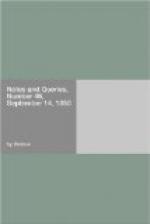E.
Sir Robert Howard.—Can any reader assist me in finding out the author of
“A Discourse of the
Nationall Excellencies of England. By R.H.,
London. Printed by Thomas
Newcomb for Henry Fletcher, at the
Three Gilt Cups in the New
Buildings, near the west end of St.
Paul’s, 1658. 12 mo.,
pp. 248.”
This is a very remarkable work, written in an admirable style, and wholly free from the coarse party spirit which then generally prevailed. The writer declares, p. 235., he had not subscribed the engagement, and there are internal evidences of his being a churchman and a monarchist. Is there any proof of its having been written by Sir Robert Howard? A former possessor of the copy now before me, has written his name on the title-page as its conjectured author. My copy of Sir Robert’s Poems, published two years after, was published not by Fletcher, but by “Henry Herringman, at the sign of the Anchor, in the lower walk of the New Exchange.” John Dryden, Sir Robert’s brother-in-law, in the complimentary stanzas on Howard’s poems, says,
“To write worthy things of worthy
men,
Is the peculiar talent of your pen.”
I would further inquire if a reason can be assigned for the omission from Sir Robert Howard’s collected plays of The Blind Lady, the only dramatic piece given in the volume of poems of 1660. My copy is the third edition, published by Tonson, 1722.
A.B.R.
Crozier and Pastoral Staff.—What is the real difference between a crozier and a pastoral staff?
I.Z.P.
Marks of Cadency.—The copious manner in which your correspondent E.K. (Vol. ii., p. 221.) has answered the question as to the “when and why” of the unicorn being introduced as one of the supporters of the royal arms, induces me to think that he will readily and satisfactorily respond to an heraldic inquiry of a somewhat more intricate nature.
What were the peculiar marks of cadency used by the heirs to the crown, apparent and presumptive, after the accession of the Stuarts? For example, what were the changes, if any, upon the label or file of difference used in the coat-armour of Henry, Prince of Wales, eldest son of James I., and of his brother Charles, when Prince of Wales, and so on, to the present time?
Miniature Gibbet, &c.—A correspondent of the Times newspaper has recently given the following account of an occurrence which took place about twenty-five years ago, and the concluding ceremony of which he personally witnessed:—




